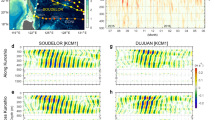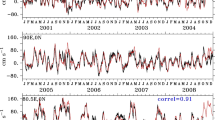Abstract
Convective variations over the tropical Indian Ocean associated with ENSO and the Indian Ocean Dipole force a Rossby wave train that appears to emanate poleward and eastward to the south of Australia and which causes climate variations across southern Australia and more generally throughout the Southern Hemisphere extratropics. However, during austral winter, the subtropical jet that extends from the eastern Indian Ocean into the western Pacific at Australian latitudes should effectively prohibit continuous propagation of a stationary Rossby wave from the tropics into the extratropics because the meridional gradient of mean absolute vorticity goes to zero on its poleward flank. The observed wave train indeed exhibits strong convergence of wave activity flux upon encountering this region of vanishing vorticity gradient and with some indication of reflection back into the tropics, indicating the continuous propagation of the stationary Rossby wave train from low to high latitudes is inhibited across the south of Australia. However, another Rossby wave train appears to emanate upstream of Australia on the poleward side of the subtropical jet and propagates eastward along the waveguide of the eddy-driven (sub-polar) jet into the Pacific sector of the Southern Ocean. This combination of evanescent wave train from the tropics and eastward propagating wave train emanating from higher latitudes upstream of Australia gives the appearance of a continuous Rossby wave train propagating from the tropical Indian Ocean into higher southern latitudes. The extratropical Rossby wave source on the poleward side of the subtropical jet stems from induced changes in transient eddy activity in the main storm track of the Southern Hemisphere. During austral spring, when the subtropical jet weakens, the Rossby wave train emanating from Indian Ocean convection is explained more traditionally by direct dispersion from divergence forcing at low latitudes.








Similar content being viewed by others
References
Ambrizzi T, Hoskins BJ, Hsu HH (1995) Rossby wave propagation and teleconnection patterns in the austral winter. J Atmos Sci 52:3661–3672
Andrews DG, McIntyre ME (1976) Planetary waves in horizontal and vertical shear: the generalized Eliassen-Palm relation and the mean zonal acceleration. J Atmos Sci 33:2031–2048
Barnes EA, Hartmann DL (2010) Influence of eddy-driven jet latitude on North Atlantic jet persistence and blocking frequency in CMIP3 integrations. Geophys Res Lett 37:L23802. doi:10.1029/2010GL045700
Cai W, van Rensch P, Cowan T, Hendon HH (2011) Teleconnection pathways of ENSO and the IOD and the mechanisms for impacts on Australian rainfall. J Clim 24:3910–3923
Cai W, Zheng X-T, Weller E, Collins M, Cowan T, Lengaigne M, Yu W, Yamagata T (2013) Projected response of the Indian Ocean dipole to greenhouse warming. Nat Geosci 6:999–1007. doi:10.1038/ngeo2009
Dee DP et al (2011) The ERA-Interim reanalysis: configuration and performance of the data assimilation system. Q J R Meteorol Soc 137:553–597
Duchon CE (1979) Lanczos filtering in one and two dimensions. J Appl Meteorol 18:1016–1022
Gill AE (1980) Some simple solutions for heat-induced tropical circulation. Q J R Meteorolol Soc 106:447–462. doi:10.1002/qj.49710644905
Hartmann DL (2007) The atmospheric general circulation and its variability. J Meteorol Soc Jpn 85:123–143
Hendon HH (2003) Indonesian rainfall variability: Impacts of ENSO and local air–sea interaction. J Clim 16:1775–1790
Hong L-C, LinHo, Jin F-F (2014) A Southern Hemisphere booster of super El Niño. Geophys Res Lett 41:2142–2149. doi:10.1002/2014GL059370
Horel JD, Wallace JM (1981) Planetary-scale atmospheric phenomena associated with the Southern Oscillation. Mon Wea Rev 109:813–829
Hoskins BJ, Ambrizzi T (1993) Rossby wave propagation on a realistic longitudinally varying flow. J Atmos Sci 50:1661–1671
Hoskins BJ, Karoly DJ (1981) Steady linear response of a spherical atmosphere to thermal and orographic forcing. J Atmos Sci 38:1179–1196
Hoskins BJ, James IN, White GH (1983) The shape, propagation and mean-flow interaction of large-scale weather systems. J Atmos Sci 40:1595–1612
Karoly DJ (1983) Rossby wave propagation in a barotropic atmosphere. Dyn Atmos Oceans 7:111–125
Karoly DJ, Plumb RA, Ting M (1989) Examples of the horizontal propagation of quasi-stationary waves. J Atmos Sci 46:2802–2811
Lau N-C, Holopainen EO (1984) Transient eddy forcing of the time-mean flow as identified by geopotential tendencies. J Atmos Sci 41:313–328
Li Y, Lau N-C (2012) Impact of ENSO on the atmospheric variability over the North Atlantic in late winter—role of transient eddies. J Clim 25:320–342
Li X, Gerber EP, Holland DM, Yoo C (2015a) A Rossby wave bridge from the tropical Atlantic to West Antarctica. J Clim 28:2256–2273
Li X, Holland DH, Gerber EP, Yoo C (2015b) Rossby waves mediate impacts of tropical oceans on West Antarctic atmospheric circulation. J Clim 28:8151–8164
Liebmann B, Smith CA (1996) Description of a complete (interpolated) outgoing longwave radiation dataset. Bull Am Meteorol Soc 77:1275–1277
Meyers G, McIntosh P, Pigot L, Pook M (2007) The years of El Nino, La Nina and interactions with the tropical Indian Ocean. J Clim 20:2872–2880
Peng S, Whittaker JS (1999) Mechanisms determining the atmospheric response to midlatitude SST anomalies. J Clim 12:1393–1408
Plumb RA (1985) On the three-dimensional propagation of stationary waves. J Atmos Sci 42:217–229
Qin J, Robinson WA (1993) On the Rossby wave source and the steady linear response to tropical forcing. J Atmos Sci 50:1819–1823
Rayner NA et al (2003) Global analyses of sea surface temperature, sea ice, and night marine air temperature since the late nineteenth century. J Geophys Res 108:4407. doi:10.1029/2002JD002670
Renwick J, Revell M (1999) Blocking over the South Pacific and Rossby wave propagation. Mon Weather Rev 127:2233–2247
Saji NH, Yamagata T (2003) Possible impacts of Indian Ocean dipole mode events on global climate. Clim Res 25:151–169
Saji NH, Goswami BN, Vinayachandran PN, Yamagata T (1999) A dipole mode in the tropical Indian Ocean. Nature 401:360–363
Saji NH, Ambrizzi T, Ferraz SET (2005) Indian Ocean Dipole mode events and austral surface air temperature anomalies. Dyn Atmos Oceans 39:87–101
Sardeshmukh PD, Hoskins BJ (1988) Generation of global rotational flow by steady idealized tropical divergence. J Atmos Sci 45:1228–1251
Shi L, Hendon HH, Alves O, Luo J, Balmaseda M, Anderson D (2012) How predictable is the Indian Ocean Dipole? Mon Weather Rev 140:3867–3884
Shinoda T, Alexander MA, Hendon HH (2004) Remote response of the Indian Ocean to interannual SST variations in the tropical Pacific. J Clim 17:362–372
Takaya K, Nakamura H (1997) A formulation of a wave-activity flux for stationary Rossby waves on a zonally varying basic flow. Geophys Res Lett 24:2985–2988
Takaya K, Nakamura H (2001) A formulation of a phase-independent wave-activity flux for stationary and migratory quasigeostrophic eddies on a zonally varying basic flow. J Atmos Sci 58:608–627
Zhao M, Hendon HH (2009) Representation and prediction of the Indian Ocean dipole in the POAMA seasonal forecast model. Q J R Meteorol Soc 135:337–352
Acknowledgements
This work was supported by the Managing Climate Variability program of the Grains Research and Development Corporation (GRDC) and the Victorian Climate Initiative (VicCI). We thank Dr. Matt Wheeler for providing updated OLR data. We are grateful for comments on an earlier version of the manuscript by Drs. E.-P. Lim and G. Wang.
Author information
Authors and Affiliations
Corresponding author
Rights and permissions
About this article
Cite this article
McIntosh, P.C., Hendon, H.H. Understanding Rossby wave trains forced by the Indian Ocean Dipole. Clim Dyn 50, 2783–2798 (2018). https://doi.org/10.1007/s00382-017-3771-1
Received:
Accepted:
Published:
Issue Date:
DOI: https://doi.org/10.1007/s00382-017-3771-1




